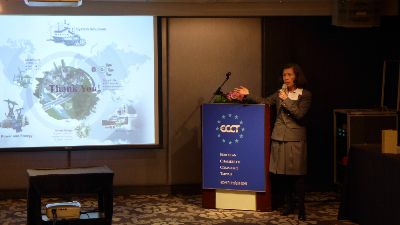Towards smarter grids and smarter homes

In his presentation, Oleg Logvinov spoke about smart systems integration and the potential to substantially reducing carbon emissions.
There is no single definition of smart grids because the term applies to a multifaceted and diverse range of technologies and solutions.There are three pillars to sustainable energy demand: 1) The optimisation of the energy source mix; 2) An increase in efficiency and 3) Smart grids.
Semiconductors are a key component in reducing global power consumption. They are used in numerous devices, each of which can achieve energy savings on a stand-alone basis and can achieve even more savings if they communicate with one another as the convergence of products and networks continues.
However, energy savings will not come from technology alone. People also need to change their behavior, become more aware of the energy they consume and take action to reduce consumption. For example, leaving electronic devices permanently plugged will consume power even when they are not in use. While the power consumed by one device may seem insignificant, the average home or office has dozens of devices consuming power unnecessarily, which over extended periods of time, add up to significant energy consumption.
Logvinov estimates that semiconductors could save an average of up to 27% energy savings between now and 2030. He gave several examples where significant energy savings are possible. For example, by completing the transition from bulbs to tubes and LEDs and by shifting from just on/off light switches to phased lighting/dimming could reduce the energy consumed by lights by 40-50%. Moreover, great savings can be made by transitioning from analogue to digital air-conditioning systems and from individual units to building control units and by switching to energy-efficient appliances.
In terms of electric mobility, the 1990s saw the mass adoption of electronic ignition, airbags and anti-lock braking systems. By 2015 we will see the widespread adoption of hybrid and purely electric vehicles, plug-in systems (with connectivity to smart grids) and autonomous tyre pressure. By 2025 will see autonomous navigation, context awareness and collision avoidance, situational awareness and image processing for safety.
In terms of the smart home, by 2015 we will see the widespread adoption of bi-directional energy meters (to allow us to get energy from the grid when needed and sell energy back to the grid from installed renewable energy systems when it is not needed for the home), remote surveillance & security devices and smart plugs. By 2020, expect to see home gateways, home controller and energy displays and situational awareness. Devices will be programmed to automatically respond to environmental conditions. For example, air-conditioning could be programmed to adjust the temperature depending on the number of people in the room while devices like washing machines could turn on only in off-peak demand periods when electricity prices are the cheapest.
The title of Lin Wen-yen's presentation was: "Smart energy: Taiwan in a global move for a better world."
In the face of climate change, it is imperative to reduce carbon emissions. Different countries are adopting different approaches and smart grids are an important component in the drive to reduce energy consumption in many countries. The majority of new smart meter installations in 2011 were in North America. Large rollouts in France, the UK and Spain will boost Europe's numbers further from 2012 onwards.
Taiwan will play a key role in the smart energy world. With well-developed and innovative global supply chains, Taiwan is well-positioned for a shift in industry focus to energy efficiency. Taiwan's utility companies and the government are beginning to pay more attention to energy efficiency in both planning and execution but there is still a need for harmonization with international standards.
Tatung is a leader in rolling out Taiwan's smart grid infrastructure. The company started with 60 "proof of concept" pilot projects in 2009 and a further 1,000 smart metering pilot projects in 2010. In 2011 and 2012, the company began cooperation with state-run electricity company, Taipower in the deployment of 10,000 high voltage smart meter units for Taiwan's major manufacturers, which collectively consume 58% of Taiwan's total power supply. By monitoring energy consumption of these major industrial users, Taipower will be able to produce and distribute energy where and when it is needed more effectively. This year, Tatung plans to begin mass deployment of low voltage metering units (for offices, commercial businesses and households). It aims to deploy 6.5 million units by 2016.
Lin concluded by saying that the technology is now available to achieve considerable energy savings. The next step is education and promotion and finally, the development of viable business models to spur the mass adoption of low carbon solutions. Ultimate success will require the joint efforts of government, corporations and the public.
For PPT, please click the links below:
